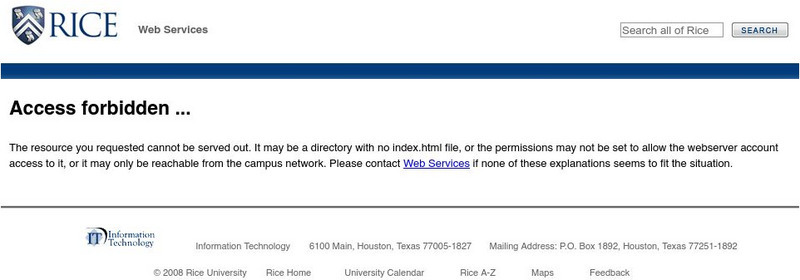A&E Television
History.com: 10 World Engineering Marvels
These remarkable feats of design and construction transformed the ways that people travel, communicate and live. For thousands of years, mankind has engineered remarkable structures such as the pyramids of Egypt and the Great Wall of...
Other
History Miami: Miami: One Hundred Years of History
An excellent discussion of Miami's colorful history from pre-European days up to modern times. Covers topics such as the Seminole Wars, the birth of Miami, the Everglades drainage project, Colored Town, the land boom, the Great...
Khan Academy
Khan Academy: Us History: 1890 1945: The Manhattan Project and the Atomic Bomb
In 1945, the United States dropped two atomic bombs on Japan, ending World War II.
Other
Japanese Canadian History: The War Years and Beyond: Years of Sorrow and Shame
The internment of Japanese Canadians during World War II is a dark time for human rights in Canada. The Japanese Canadian History Project looks at events and the impact on the Japanese community, and on the broader Canadian community.
Rice University
Rice University: The Heights Remembers: World War Ii
An oral history project done by Rice University and a middle school who recorded the memories of WWII that members of their neighborhood had.
Other
World Nuclear Association: Outline History of Nuclear Energy
Discusses the nature of the atom, harnessing nuclear fission, conceiving the atomic bomb, the Manhattan Project, and the revival of the nuclear boiler.
A&E Television
History.com: How the Ancient Greeks Designed the Parthenon to Impress and Last
This icon of classical architecture perched atop the Acropolis has dominated the Athens skyline for 2,500 years. Few monuments in the world are more recognizable than the Parthenon. Sitting atop a limestone hill rising some 500 feet...
Khan Academy
Khan Academy: Motivation for European Conquest of the New World
God, gold, and glory motivated European nations to explore and create colonies in the New World. This article discusses the Crusades and how they influenced European colonization projects.
Text Project
Text Project: Fyi for Kids: Vol. 2, Issue 9: Noodles Around the World [Pdf]
Read this magazine article to learn all about noodles or pasta including their history, materials used, names, and how it is eaten.
Other
Northwest College Wyoming: Heart Mountain Digital Preservation Project
Heart Mountain, Wyoming, was one of the Japanese relocation centers used during World War II. Read the history of the center, then browse the many original photos, conveniently sorted by topic. Some primary documents are also available...
Khan Academy
Khan Academy: Darwin, Evolution, and Faith
Can ancient scriptural accounts of the world's creation by God be reconciled with Darwin's new story? This article looks at three responses to this question: Conflict, Contrast, and Convergence.
PBS
Pbs Learning Media: Decolonizing the Map: Creating the Indigenous Mapping Collective
For many Indigenous communities, mapping plays a large role in reclaiming their lands. Mapping is not new to Indigenous peoples, in fact, some of the world's earliest maps can be seen in cave paintings or heard in the stories that have...
Khan Academy
Khan Academy: The Columbian Exchange
The rapid pace of globalization today is a continuation and acceleration of processes that began 500 years ago. This article discusses that not only humans started to travel the world, but also plants, species, bacteria, and viruses....
Khan Academy
Khan Academy: Uruk
Nestled between the Tigris and Euphrates rivers, the world's first major city sprang up in a fertile region of land called Mesopotamia. This article discusses the kings, writing, monumental temples and palaces, specialized occupations,...
Khan Academy
Khan Academy: Timekeeping
Why do we need calendars and clocks? To survive in this complex society, you need to track what others are doing and when they're doing it. You also need to know what's happening in the natural world. This article discusses how/why...
Khan Academy
Khan Academy: Collective Learning (Part 4)
In the final essay of a four-part series, David Christian explains how advances in communication and transportation accelerated collective learning.









